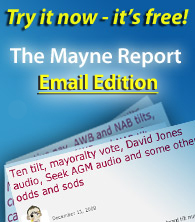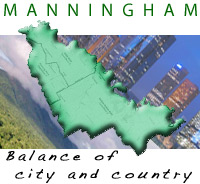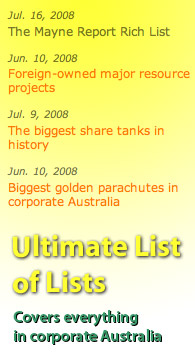Macquarie at Beaconsfield, Peter Beattie and Babcock controls media coverage
July 22, 2008
Here are Stephen Mayne's five stories from the Crikey edition on Thursday, 27 April, 2006.
4. Did Macquarie do
everything it could at Beaconsfield?
By
Stephen Mayne
Michael Ryan, the Macquarie Bank-appointed
administrator of Allstate Exploration,
operator of the Beaconsfield goldmine in Tasmania, has hired
crisis manager Anthony McClellan to help him get through the tragedy of the
rock fall which appears to have killed three miners.
The mainstream media has so far largely steered clear of the angle that the
mine has been mired in controversy and litigation, but Macquarie Bank is now
sure to face further questions about one of the world's richest companies still
in administration.
The Australian's Michael West won
the business Walkley last year for his reporting on Macquarie Bank's dealings
at Beaconsfield
but the paper is also facing an aggressive defamation action from the
Millionaire Factory which certainly hasn't enjoyed the attention during what
has been quite a media campaign.
Macquarie originally lent $21 million to
Allstate and after appointing Michael Ryan as administrator, it bought $77
million of inter-company loans for just $300,000. Suddenly the mine turned
around, the gold price spiked and Allstate was swimming in cash but will remain
in administration until Macquarie has
collected its entire $77 million.
So far it has recovered about $35 million, including the full $21 million original
loan, so the next $65 million or so will be pure profit. Allstate owns 51% of
the mine and is the operator so Michael Ryan is the man ultimately responsible,
which explains why he's taken on McClellan, whose column
in The Australian's Media section
today is headlined "You must remember this: if it's a rumour, give it a
miss".
McClellan is taking aim at Glenn Milne's appalling column speculating about Kim
Beazley's health but he's no doubt going to have to deal with plenty of
speculation as to whether Macquarie Bank, which has two executives on the joint
venture committee and clearly controls the Beaconsfield operation through Ryan, could
have done more.
For instance, check out the announcement
Allstate made on 29 December last year under the headline "Geotechnical
& Mining Method Review". This review was undertaken following a
"large seismic event," which occurred on 26 October last year, and
"highlighted work to be done throughout the mine, with a recommendation
for increased levels of ground support in certain areas".
Clearly, the full report will need to be publicly released to assess
whether Macquarie implemented all the recommendations made by
AMC, one of the leading geophysicist advisors around. One of the
Macquarie Bank
executives on the joint venture committee, Warwick Morrris, is a
geophysicist
himself, so he'll no doubt be briefing his bosses at the bank about
what it all
means.
So far, the idea of a tremor causing a rock fall leaves Macquarie
looking blameless – how do you prepare for a minor earthquake? However,
if the report made recommendations which were not followed – and we hear
this practice called checkerboarding is a key issue – then things might
start to get uncomfortable for the Millionaire Factory on something that was
proving to be close to the biggest bonanza they've ever enjoyed.
7. Peter Beattie's
smart asset shuffle
By
Stephen Mayne
Ever since the early days of Joh Bjelke-Petersen's premiership, Queensland has been Australia's richest state when it
comes to public finances. There was no need for a Kennett-style $30 billion
energy sell-off in the mid-1990s, there was no collapse of the Queensland State
Bank and public sector superannuation has always been fully funded. This has
allowed Queensland to easily claim the title
of Australia's
"lowest taxing state", a fact which is best demonstrated by the
absence of any state-based fuel tax – something no other state or
territory can sustain.
The power of Queensland Inc's balance sheet was demonstrated when the
government-owned Port of Brisbane Authority snapped up almost 40% of Brisbane
Airport from the Federal Government in 1996-97.
Even more eyebrows were raised when Queensland Rail last month splashed $446
million on the "above rail" operations of WA-based ARG and Ergon
Energy spent $103 million buying Melbourne-based listed electricity retailer
Australian Energy. Observers noted that Ergon wanted Australian Energy's six
years of operating experience in competitive markets as full retail competition
approached on its home turf next year.
When all this talk suddenly emerged after the Toll-Patrick peace deal of
Queensland Rail also spending up to $1 billion buying Linfox, FCL or even 50%
of Pacific National, questions started to be asked about the broader game plan
and where the money would come from. Now we might just have some answers.
Australian Energy was clearly bought to make Ergon and Energex more saleable
propositions. Could the same occur with Queensland Rail once it completes its
plans to expand nationally?
From a Queensland
budget point of view, the estimated $1 billion from the sale of Ergon and
Energex could be injected straight into Queensland Rail. The timing of the deal
is excellent given the buoyant market for energy assets. Maybe even Snowy Hydro
could be considered as a potential buyer if the vendor governments leave it
with a strong enough balance sheet.
The Victorian Government leapt through a unique window of opportunity in
securing $30 billion for its energy assets between 1994 and 1999 – namely
the US was deregulating and
most of their giant power utilities wanted to experience Victoria's world leading competitive market
model in readiness for the same process at home.
The Kennett Government just happened to find the two right blokes – Dr
Peter Troughton to break up the industry and investment banker John Wylie to
run the global auctions of about 15 different businesses over a four-year
period – at exactly the right time.
However, many of the new owners of these very same assets – Origin, AGL,
CKI, Singapore Power and the like – are now the most likely buyers of
Ergon and Energex. The Beattie Government could easily have opted for the
populist public float option, but perhaps they learnt a lesson when the
Queensland TAB was floated for $2 a share in 1999 but now trades as Unitab and
closed at $14.82 yesterday.
Markets need to become comfortable with business models before floats can
really deliver great value – something the Kennett Government learnt the
hard way in fetching just $2.25-a-share in the 1994 Tabcorp float. In
hindsight, Kennett should have instead just floated a minority stake and
flogged the rest for a much higher price a few years later once the market
better understood its operations and after some rationalisation of the
state-based totes.
A similar argument might just apply to Snowy Hydro given that analysts are
still coming to grips with the notion of more than half its revenue coming from
seemingly bizarre insurance policies that rely on the company not starting its
generators. Energy retailing is now much better understood by investors but
Beattie is clearly out to maximise the proceeds by welcoming foreign bidders as
well.
18. How Babcock
minimised media coverage of record pay packets
By
Stephen Mayne, occasionally over-zealous media critic
There's nothing worse in this game than to make a mistake when sledging the media
for missing a yarn or getting things wrong. That's why Media Watch has to be as close to
mistake-free as possible, because they'll cop a real hiding if any blunder of
their own surfaces.
Another common media occurrence is the old make-good story where you
essentially correct the record but attempt to dress it up as a separate news
story or a development on what you previously argued. This item is an example
of both these trends.
Firstly, I was wrong on Monday in saying the Babcock & Brown annual report
was out that morning, when in fact it had been lodged with the ASX at 12.54pm
on Friday afternoon. The square-up item yesterday then went further in
attacking the mainstream media for missing the story of Babcock's soaring
executive pay packets for three days until we ran with it.
However, this was wrong because all the pay details were actually made public
when Babcock released its 190-page full financial report on 30 March. The press
and analysts were invited to briefings when the full-year result was released
on 23 February and it generated plenty of excitement, but there was no fanfare
surrounding the 30 March release and the pay detail was duly missed by all the
mainstream media, although The AFR
did manage a six sentence brief on page ten which started as follows but
covered no other executives:
Babcock & Brown
chief executive Phil Green has entrenched his status as one of the country's
highest-paid executives, earning more than $12 million last year for steering
the fast-growing investment house through its first year as a listed company.
Mr Green enjoyed an 18% pay rise after the investment house posted a near
doubling of annual profit to $251.6 million.
This process is
highly unusual because most companies simply announce their profit result and then
the pay details are released in the annual report a few weeks later along with
the notice of meeting for the AGM, which reveals any new equity issues and pay
rises for non-executive directors. The Babcock strategy of introducing a third
disclosure date certainly worked a treat if the idea was to minimise press
comment on their record pay packets. Presumably hacks who saw the 30 March
release just assumed it was a repeat of the profit information, when in fact it
contained some great stories on executive pay.
Therefore, my attack yesterday still stands in the sense that the media as a
whole failed to report the Babcock pay details in a comparable way to the
treatment Macquarie Bank copped last year, despite the fact that they are
comparable companies – we are talking about the two highest paying listed
companies in Australia. However, I'm still a goose for claiming on Monday that
something was fresh news that morning, when in fact the document I was relying
on was made public three days earlier and the information that I claimed was
newsworthy in that document had actually been released seven weeks before.
The fact that , and all
produced follow-ups to our Monday story is a tacit admission that it was a good
yarn that they'd missed. However, I was slack for missing it too and it would
have been better to simply get all the facts right from the outset.
But presumably Babcock was happy with how things panned out. The information in
the annual report was largely in place on 30 March yet it wasn't released in
the annual report until last Friday afternoon – the Friday before the
ANZAC Day long weekend and also the last Friday available in order to have the
AGM on the last Friday available, namely Friday 26 May. We all know that Friday
is the best day to release bad news because newspapers have early deadlines,
the news pages are squeezed by all those supplements and there are no Saturday
shock jocks to beat you around the ears.
It worked a treat for Babcock and it will be interesting to see how the equally
unusual Macquarie strategy of releasing all the pay figures in the annual
profit announcement goes. That will occur on 18 May – the very day that
BRW's 2006 Rich List goes public. BRW has never included a Macquarie or Babcock
banker but we estimate that about a dozen of them are worth more than last
year's $110 million cut-off, so it will be very interesting to see how they go
this year given the soaring pay packets and share prices over the past 12
months.
19. Sky News – channel of the year and blundering amateurs
By
Stephen Mayne, triple Foxtel digital subscriber who pays for lots of extra
channels
There wouldn't be many Australian homes who support Foxtel as enthusiastically
as the Maynes and we're pretty happy with the service. The better half enjoys
old episodes of Sex in The City, the kids would happily watch Nick Junior all
day and I like the music channels plus the generally excellent offering on Sky
News.
And with Foxtel finally breaking into profit after ten years of losses, you
couldn't blame the pay-TV players for yesterday patting themselves on the back
at one of those "glittering award nights" held for the industry at
Fox Studios. Claudia Karvan was voted the most popular female character for her
role in Love My Way on Fox 8, Lifestyle's Brendan Moore got gonged and Sky News
received three awards, including "channel of the year". However, in
one of those unfortunate juxtapositions, a disaster was unfolding on the
"channel of the year" just as the awards were getting into full
swing.
It has now been more than a year since David Koch and Michael Pascoe were
booted out of Sky Business Report, the nightly half hour program which goes to
air at 8.30pm and is repeated at 11.30pm. The two veterans were initially
replaced by 21-year-old Brooke Forster, but then Karen Tso was parachuted into
the chair as part of a re-launch that saw the program produced in conjunction
with The Australian.
Given what went to air last night, Karen must be wishing she was still doing
the finance updates for Tony Jones on Lateline. For starters, the autocue
obviously wasn't working because Karen was constantly looking down at a piece
of paper as she introduced the program. Then there were a couple of brief
glitches with the sound and picture, but it got worse when a story on oil
prices featured a long grab from Peter Costello with no sound.
Karen advised at the outset that a detailed interview with AGL CEO Paul Anthony
was coming up later in the program so I stuck around out of interest to hear
his Welsh accent and learn more about yesterday's peace deal with Alinta.
Sadly, Karen introduced the interview and once again we got a silent picture of
a man talking. After about 30 seconds Karen came back and apologised for the
technical glitch and went to what was obviously a filler story about Sydney
Fashion Week but that also had no sound.
The program usually finishes with a summary of the headlines in The
Australian's business section the next day but when Karen bid farewell to her
10,000-plus viewers prematurely at 8.50pm we only had them read out rather than
displayed.
So how do you fill ten minutes of live news coverage? Sky first opted for a
house ad plugging The Australian. The catch-line was: "Are you an informed
Australian?" Certainly not after watching last night's Sky Business
Report.
The last five minutes of the program were filled with an interview by sports
reporter Craig Norenbergs with Kyle Patterson about his not-so-new book
Football for Dummies. Has anyone ever produced a book called Live TV for
Dummies? Maybe it was just a case of everyone being on the booze at Fox
Studios. Thankfully the repeat of the program at 11.30pm fixed up most of the
blunders but only really sad cases like me would have stayed up to find out.
25. Annual reports go voluntary – sell PMP
By
Stephen Mayne
The Federal Government yesterday announced a controversial move: making the
distribution of annual reports by listed companies voluntary. The change will
probably save almost $100 million a year spread across the 1,600-plus listed
companies and the two biggest losers will be PMP, Australia's biggest printing
company, and the government itself through Australia Post.
At the moment, companies must send out hard copies of the annual report unless
a shareholder expressly asks not to receive it. Now the default option will be
not sending it unless you inform the company you want it.
As the holder of Australia's biggest small portfolio – 100 different stocks
worth $69,768 after the partial sale of eight small stakes yesterday – at
one level, I should be outraged that the annual reports won't automatically be
sent out. However, my experience is proof positive of the enormous
environmental waste because our PO Box regularly overflows with company
missives that usually just get binned.
News Ltd's Terry McCrann was on the money in lauding the move today as
"one small step for mankind, one huge win for trees". However,
there's a certain irony about McCrann's criticism of laws that still require
companies "to waste millions putting meaningless rubbish in their annual
reports" and then spend even more sending them to an overwhelming majority
of shareholders who turf them "straight in the bin".
So what would be the next obvious move to save trees? How about cutting back on
all those meaningless supplements that pad out newspapers these days? And what
about giving residents the choice of opting not to receive Rupert's suburban
give-aways across the nation? Many people never look at the local paper but in
Victoria, alone Rupert's Leader Newspapers group dumps 1.43 million in
letterboxes without permission every week.
Finally, let's hope this change stops the practice of struggling companies
forcing small shareholders to sell up against their wishes as a cost-saving
measure. An ERG shareholder explains:
Have
you seen ERG's latest? I had a letter today telling me that small shareholders
are costing it a lot of money in administration, therefore they are invoking
rule 5.5 of their constitution which empowers them to sell up these shares no
doubt at current prices. In my case this means that my initial outlay of over
$4,000 (with no interim dividends) is now worth less than half through their
bad organisation and they are about to rip me off of any chance to make a
profit if they come good. I think it is outrageous.
Indeed.
David Koch's old outfit Palamedia is still yet to do this to me even though the
original $200 investment is now down to just $2. Still, it's interesting to
read the annual report each year.
Copyright © 2024 The Mayne Report. All rights reserved






















